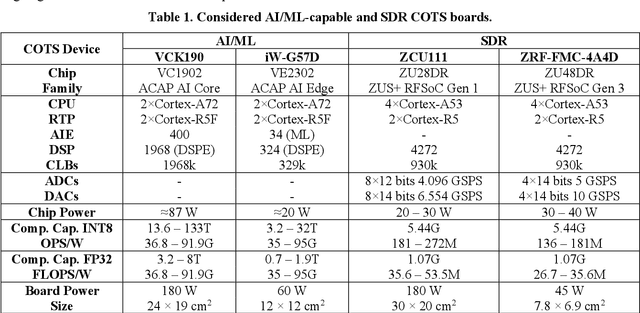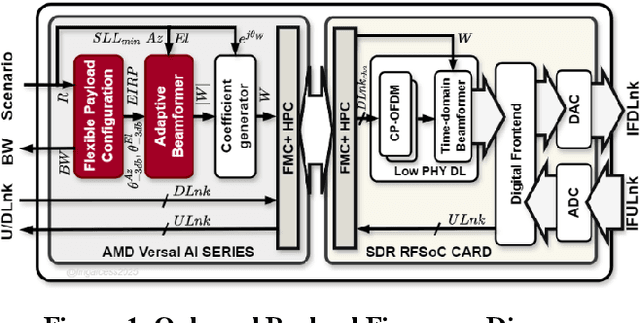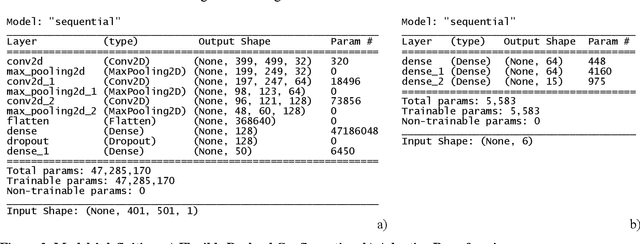Eva Lagunas
Decentralized Cooperative Beamforming for Networked LEO Satellites with Statistical CSI
Dec 21, 2025Abstract:Inter-satellite-link-enabled low-Earth-orbit (LEO) satellite constellations are evolving toward networked architectures that support constellation-level cooperation, enabling multiple satellites to jointly serve user terminals through cooperative beamforming. While such cooperation can substantially enhance link budgets and achievable rates, its practical realization is challenged by the scalability limitations of centralized beamforming designs and the stringent computational and signaling constraints of large LEO constellations. This paper develops a fully decentralized cooperative beamforming framework for networked LEO satellite downlinks. Using an ergodic-rate-based formulation, we first derive a centralized weighted minimum mean squared error (WMMSE) solution as a performance benchmark. Building on this formulation, we propose a topology-agnostic decentralized beamforming algorithm by localizing the benchmark and exchanging a set of globally coupled variables whose dimensions are independent of the antenna number and enforcing consensus over arbitrary connected inter-satellite networks. The resulting algorithm admits fully parallel execution across satellites. To further enhance scalability, we eliminate the consensus-related auxiliary variables in closed form and derive a low-complexity per-satellite update rule that is optimal to local iteration and admits a quasi-closed-form solution via scalar line search. Simulation results show that the proposed decentralized schemes closely approach centralized performance under practical inter-satellite topologies, while significantly reducing computational complexity and signaling overhead, enabling scalable cooperative beamforming for large LEO constellations.
Multilayer Non-Terrestrial Networks with Spectrum Access aided by Beyond-Diagonal RIS
Oct 06, 2025Abstract:In this work, we study a multi-user NTN in which a satellite serves as the primary network and a high-altitude platform station (HAPS) operates as the secondary network, acting as a cognitive radio. To reduce the cost, complexity, and power consumption of conventional antenna arrays, we equip the HAPS with a transmissive BD-RIS antenna front end. We then formulate a joint optimization problem for the BD-RIS phase response and the HAPS transmit power allocation under strict per-user interference temperature constraints. To tackle the resulting highly nonconvex problem, we propose an alternating-optimization framework: the power-allocation subproblem admits a closed-form, water-filling-type solution derived from the Karush-Kuhn-Tucker (KKT) conditions, while the BD-RIS configuration is refined via Riemannian manifold optimization. Simulation results show significant gains in data rate and interference suppression over diagonal RIS-assisted benchmarks, establishing BD-RIS as a promising enabler for future multilayer NTNs.
Hybrid Table-Assisted and RL-Based Dynamic Routing for NGSO Satellite Networks
Sep 18, 2025Abstract:This letter investigates dynamic routing in Next-Generation Satellite Orbit (NGSO) constellations and proposes a hybrid strategy that combines precomputed routing tables with a Deep Q-Learning (DQL) fallback mechanism. While fully RL-based schemes offer adaptability to topology dynamics, they often suffer from high complexity, long convergence times, and unstable performance under heavy traffic. In contrast, the proposed framework exploits deterministic table lookups under nominal conditions and selectively activates the DQL agent only when links become unavailable or congested. Simulation results in large-scale NGSO networks show that the hybrid approach consistently achieves higher packet delivery ratio, lower end-to-end delay, shorter average hop count, and improved throughput compared to a pure RL baseline. These findings highlight the effectiveness of hybrid routing as a scalable and resilient solution for delay-sensitive satellite broadband services
In-Lab Carrier Aggregation Testbed for Satellite Communication Systems
Aug 26, 2025Abstract:Carrier Aggregation (CA) is a technique used in 5G and previous cellular generations to temporarily increase the data rate of a specific user during peak demand periods or to reduce carrier congestion. CA is achieved by combining two or more carriers and providing a virtual, wider overall bandwidth to high-demand users of the system. CA was introduced in the 4G/LTE wireless era and has been proven effective in 5G as well, where it is said to play a significant role in efficient network capacity management. Given this success, the satellite communication (SatCom) community has put its attention into CA and the potential benefits it can bring in terms of better spectrum utilization and better meeting the user traffic demand. While the theoretical evaluation of CA for SatCom has already been presented in several works, this article presents the design and results obtained with an experimentation testbed based on Software Defined Radio (SDR) and a satellite channel emulator. We first present the detailed implementation design, which includes a Gateway (GW) module responsible for PDU-scheduling across the aggregated carriers, and a User Terminal (UT) module responsible for aggregating the multiple received streams. The second part of the article presents the experimental evaluation, including CA over a single Geostationary (GEO) satellite, CA over a single Medium Earth Orbit (MEO) satellite, and CA combining carriers sent over GEO and MEO satellites. A key contribution of this work is the explicit consideration of multi-orbit scenarios in the testbed design and validation. The testing results show promising benefits of CA over SatCom systems, motivating potential upcoming testing on over-the-air systems.
DT-Aided Resource Management in Spectrum Sharing Integrated Satellite-Terrestrial Networks
Jul 28, 2025Abstract:The integrated satellite-terrestrial networks (ISTNs) through spectrum sharing have emerged as a promising solution to improve spectral efficiency and meet increasing wireless demand. However, this coexistence introduces significant challenges, including inter-system interference (ISI) and the low Earth orbit satellite (LSat) movements. To capture the actual environment for resource management, we propose a time-varying digital twin (DT)-aided framework for ISTNs incorporating 3D map that enables joint optimization of bandwidth (BW) allocation, traffic steering, and resource allocation, and aims to minimize congestion. The problem is formulated as a mixed-integer nonlinear programming (MINLP), addressed through a two-phase algorithm based on successive convex approximation (SCA) and compressed sensing approaches. Numerical results demonstrate the proposed method's superior performance in queue length minimization compared to benchmarks.
Swarm Intelligence Optimization of Multi-RIS Aided MmWave Beamspace MIMO
May 20, 2025Abstract:We investigate the performance of a multiple reconfigurable intelligence surface (RIS)-aided millimeter wave (mmWave) beamspace multiple-input multiple-output (MIMO) system with multiple users (UEs). We focus on a challenging scenario in which the direct links between the base station (BS) and all UEs are blocked, and communication is facilitated only via RISs. The maximum ratio transmission (MRT) is utilized for data precoding, while a low-complexity algorithm based on particle swarm optimization (PSO) is designed to jointly perform beam selection, power allocation, and RIS profile configuration. The proposed optimization approach demonstrates positive trade-offs between the complexity (in terms of running time) and the achievable sum rate. In addition, our results demonstrate that due to the sparsity of beamspace channels, increasing the number of unit cells (UCs) at RISs can lead to higher achievable rates than activating a larger number of beams at the MIMO BS.
Multi-Active RIS-Assisted THz Cell-Free Systems: Spectral and Energy Efficiency Tradeoff
May 13, 2025Abstract:Reconfigurable intelligent surfaces (RISs) and cell-free massive multiple-input multiple-output (CF-mMIMO) are effective solutions for mitigating large path loss and inter-cell interference in terahertz (THz) systems. However, passive RISs are notably limited from double-fading attenuation, motivating the use of active RISs with power amplification to improve signal strength. In this paper, we investigate a multi-active RIS-aided wideband CF-mMIMO system for THz communications, considering low-resolution digital-to-analog converters (DACs) to optimize the spectral efficiency (SE)-energy efficiency (EE) tradeoff by adjusting precoding vectors and reflection coefficient response of the RISs, subject to power and minimum desirable per-user rate constraints. This leads to a highly complex and non-convex, multi-objective and fractional optimization problem. To solve it, we propose a tailored quadratic transformation to manage the fractional form. This allows decomposition into two subproblems, which are iteratively solved via a successive convex approximation algorithm to optimize the precoding vectors and active RIS reflection coefficients until convergence. Numerical results demonstrate that the proposed active RIS-aided CF-mMIMO system effectively addresses propagation loss and limited scattering in THz communication, achieving superior EE and SE compared to conventional passive RIS across diverse scenarios. Furthermore, the integration of low-resolution DACs shows significant improvement in EE while preserving satisfactory communication performance.
SmartUT: Receive Beamforming for Spectral Coexistence of NGSO Satellite Systems
May 12, 2025Abstract:In this paper, we investigate downlink co-frequency interference (CFI) mitigation in non-geostationary satellites orbits (NGSOs) co-existing systems. Traditional mitigation techniques, such as Zero-forcing (ZF), produce a null towards the direction of arrivals (DOAs) of the interfering signals, but they suffer from high computational complexity due to matrix inversions and required knowledge of the channel state information (CSI). Furthermore, adaptive beamformers, such as sample matrix inversion (SMI)-based minimum variance, provide poor performance when the available snapshots are limited. We propose a Mamba-based beamformer (MambaBF) that leverages an unsupervised deep learning (DL) approach and can be deployed on the user terminal (UT) antenna array, for assisting downlink beamforming and CFI mitigation using only a limited number of available array snapshots as input, and without CSI knowledge. Simulation results demonstrate that MambaBF consistently outperforms conventional beamforming techniques in mitigating interference and maximizing the signal-to-interference-plus-noise ratio (SINR), particularly under challenging conditions characterized by low SINR, limited snapshots, and imperfect CSI.
Artificial Intelligence implementation of onboard flexible payload and adaptive beamforming using commercial off-the-shelf devices
May 03, 2025



Abstract:Very High Throughput satellites typically provide multibeam coverage, however, a common problem is that there can be a mismatch between the capacity of each beam and the traffic demand: some beams may fall short, while others exceed the requirements. This challenge can be addressed by integrating machine learning with flexible payload and adaptive beamforming techniques. These methods allow for dynamic allocation of payload resources based on real-time capacity needs. As artificial intelligence advances, its ability to automate tasks, enhance efficiency, and increase precision is proving invaluable, especially in satellite communications, where traditional optimization methods are often computationally intensive. AI-driven solutions offer faster, more effective ways to handle complex satellite communication tasks. Artificial intelligence in space has more constraints than other fields, considering the radiation effects, the spaceship power capabilities, mass, and area. Current onboard processing uses legacy space-certified general-purpose processors, costly application-specific integrated circuits, or field-programmable gate arrays subjected to a highly stringent certification process. The increased performance demands of onboard processors to satisfy the accelerated data rates and autonomy requirements have rendered current space-graded processors obsolete. This work is focused on transforming the satellite payload using artificial intelligence and machine learning methodologies over available commercial off-the-shelf chips for onboard processing. The objectives include validating artificial intelligence-driven scenarios, focusing on flexible payload and adaptive beamforming as machine learning models onboard. Results show that machine learning models significantly improve signal quality, spectral efficiency, and throughput compared to conventional payload.
Enhancing Physical Layer Security in Cognitive Radio-Enabled NTNs with Beyond Diagonal RIS
Mar 20, 2025Abstract:Beyond diagonal reconfigurable intelligent surfaces (BD-RIS) have emerged as a transformative technology for enhancing wireless communication by intelligently manipulating the propagation environment. This paper explores the potential of BD-RIS in improving cognitive radio enabled multilayer non-terrestrial networks (NTNs). It is assumed that a high-altitude platform station (HAPS) has set up the primary network, while an uncrewed aerial vehicle (UAV) establishes the secondary network in the HAPS footprint. We formulate a joint optimization problem to maximize the secrecy rate by optimizing BD-RIS phase shifts and the secondary transmitter power allocation while controlling the interference temperature from the secondary network to the primary network. To solve this problem efficiently, we decouple the original problem into two sub-problems, which are solved iteratively by relying on alternating optimization. Simulation results demonstrate the effectiveness of BD-RIS in cognitive radio-enabled multilayer NTNs to accommodate the secondary network while satisfying the constraints imposed from the primary network.
 Add to Chrome
Add to Chrome Add to Firefox
Add to Firefox Add to Edge
Add to Edge